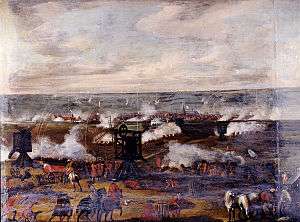Siege of Malmö
| ||||||||||||||||||||||||||||||
The Siege of Malmö was a conflict between Danish troops and Swedish defenders of the city of Malmö, fought on the night of June 25 and 26 (Julian calendar), 1677. Fought toward the end of the Scanian War, the siege was one in a string of Danish losses that saw the Swedish forces under Charles XI of Sweden take control of the land battles in southern Sweden.
Prelude
The fortified town of Malmö was the only Swedish stronghold that had not fallen into the hands of the Danes and during 1676 and 1677 it was used as a base for Swedish operations in the southwest corner of Skåne. To win the war king Christian V therefore had to capture Malmö. The siege began on June 10, when the Danish navy anchored in the roadstead north of the town and the Danish army camped on the plain south of the town. Danish engineers soon begun digging trenches leading up to the castle in the west and to the eastern and southern gates in the town wall. On the 12 the Danes brought in 28 siege guns and 27 mortars that started bombarding the castle and the town walls. The Swedish administration was not sure about the loyalty of the civilian citizens as they had only been under Swedish rule since 1658. But reports from Kristianstad about how the Danish king Christian V had allowed his soldiers three hours of plunder after the capture of the town in August 1676 ensured the citizens that their best option was to support the Swedes.
Battle
The bombardment became more intense on the evening of the 25th, and at 1 o'clock in the morning the battle began with a Danish sham attack on the castle Malmöhus, followed by two full attacks on the city, one at the southern gate (Söderport) and one at the eastern gate (Österport). The Danes used fascines, ladders and pontoons to cross the moat. After a fearsome fight the Danish guard under command of Siegfried von Bibow was able to break through the defence close to the eastern gate. However, as soon as Danish troops reached the crest of the town wall the Danish artillery ceased to fire, which gave the defenders the opportunity to man their guns. The Swedish artillery soon begun firing on Danish troops making their way across the moat, which killed a lot of Danish soldiers and made it impossible for the Danes to bring reinforcements to von Bibow. Inside the town, von Bibow had too few men to force his way to the gate and open it, and eventually he and all his men were cut down by Swedish soldiers and townsmen. Another attack on the other side of the eastern gate made it to the crest of the wall, but no further, while the attacks at the southern gate failed to even cross the moat.
Aftermath
On the 5 July the Danish army began its retreat north to Landskrona. The Danes had lost the initiative in the war, as well as its best troops and some of its most skilled commanders. It has been suggested that the later is one of the main reasons why the Danes lost at the battle of Landskrona a few weeks later. While the Danish navy had the upper hand over the Swedish, the siege was one of a number of Swedish victories on land that would, in the end, restore the status quo of Scania being under Swedish control.[1]
References
- ↑ Martin, Henri (1865). Martin's history of France: the age of Louis XIV. Walker, Wise and co. p. 455.
Coordinates: 55°35′40″N 13°01′05″E / 55.5944°N 13.0181°E
